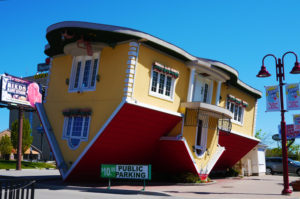FLIPPING HOUSES? ISN’T THAT SUPER-HIGH RISK?
Grab your favourite hot chocolate, and whatever hat you use to think outside the box!
House flipping stories make for the most dramatic television on HGTV. You can watch a seasoned “flipper” make thousands, and a rookie flipper lose thousands. These days, you can even watch experienced flippers “teach” the rookies how to do it—and point out all of the beginner’s mistakes.
We started as renovators first, then became real estate investors. So we LOVE ugly houses. But we don’t love the high risk scenarios that are often portrayed on fixer-upper tv shows.
A few years ago, we learned about the theory of “Flip to Yourself,” or the BRRR strategy (Buy, Renovate, Rent, Refinance). Two expressions that essentially mean the same thing to real estate investors: take an ugly house, fix it, then make it glamourous, and … KEEP IT.
Here’s what happens. An investor buys an ugly house with good bones and in a good location. We can fix just about anything after 13 years of residential renovations—but that doesn’t mean we should! So we look for houses that don’t have major structural issues.
But it’s not just about the house. The secret sauce is all about the numbers! Before the purchase, it is important to partner with experienced realtors, who can estimate what the home will sell for after the renovation. There is no guarantee, but we’ve checked our math before we sign the Offer.
Now back to the house. Outside, we like ugly yards, overgrown plants, bright orange paint, etc… Then when we go inside: we love old wood paneling, tiki bars in the basement (must have been all-the-rage at some point because we see it a lot!), and old 80’s pastels. Garbage and damaged drywall are no big deal, since we’ll be doing a big reno anyways.
Let’s talk numbers. If we negotiate a great deal, we might need to pay $250,000 for that property. Then the renovation estimate might come in around $80,000. We’ll add in a generous buffer (contingency fund) for the things we can’t see on an inspection; we may even round up to $100,000 for our reno budget. Can it be done cheaper? Sometimes yes! But we’d always rather under-promise and over-deliver.
When we get to work on the house, there will be carrying costs: taxes, insurance, heat, electrical, and maybe even condo fees. These can cost around $1000 per month (sometimes more). And then there will be financing costs: interest on the money we borrowed to pay for the renovations, or sometimes the money that is borrowed to purchase the property. For easy math, let’s say we borrow the $100,000 at 12% simple interest; our financing costs would be $1000 per month.
If we need 6 months to renovate – and yes, it can likely be done faster – then we calculate our budget as $100,000 for the renovations and roughly $25,000 for the carrying costs and financing costs. Add this to the purchase price of the house, and we have invested a total of $375,000.
Once the house has been glammed up, we can do a traditional flip. BUT, this will cost us an extra $20,000 approximately in real estate commissions. And, WHAT IF the market has gone down in the 6 months where we’ve been working hard on our renovations?
This is where the BRRR or Flip to Yourself takes a lot of the risk out of the equation. Our big question now becomes, “how much will we keep?”
Now, we get the house appraised and get it rented to great tenants. BRRR = Buy, Renovate, Rent, Refinance. To our delight, the appraisal comes in at $450,000. Ready for some math “magic?”
If the bank provides a traditional mortgage for an investor, the bank will finance up to 80% of the appraised price = $360,000. We could potentially “own” the property for only $15,000 down—after the renovations! In the refinance, we will receive almost all of our investment back—and be able to carry it IN the mortgage.
YES, this strategy takes time and sweat equity (or management of your reno trades people).
YES, there are still risks with any real estate purchase, and with any renovation.
But yes, this takes A LOT of the risk out of traditional flipping where the primary strategy is to sell the house. When you flip to yourself, you have the ability to hold a fully renovated house for many years. Imagine 10 years of mortgage paydown, 10 years of cashflow, and the potential for 10 years of slow passive appreciation (if the market rises above where it is today). Did I mention we love long-term buy and holds, especially in today’s market?
We use our renovation skills when the numbers make sense. And today, we are simply sharing another option with our friends and family, so each investor can choose which strategies suit their timeline and their risk tolerance. There are many ways to reach your #financialfreedom through real estate investing. Chat with us anytime to learn more.


